The origin and expansion of puppetry
by W.T.J.S. Kaviratne, Ambalangoda Special Cor.
All forms of art including folklore and folk dances of whatever
nation can be considered didactic in nature.
 These art forms try to convey a message having a universal bearing to
society and its individual members, either through visual or linguistic
means. These art forms try to convey a message having a universal bearing to
society and its individual members, either through visual or linguistic
means.
Traditional folk dances of Kolam Nadagam and ' Puppetry ' portray the
frailties of humanity,conflicts, fate , successes and vicissitudes of
life in tune with the pattern of behaviour of the people in society.
Humour and sarcasm are prominently portrayed and ingeniously infused
in the folk dances to satisfy audiences, whether the themes are based on
religious literature, historical episodes or contemporary social issues.
Traditional puppetry is a form of folk dances using characters made
out of wood. The wooden figures can be animated by the artists using
strings.
The concept of puppetry is as old as the hills according to
anthropologists.
Origin
The history of puppetry is more than 30,000 years old. Similarly,
some anthropologists say that the origin of puppetry is contemporaneous
with the history of human civilisation.
Greek philosophers such as Aristotle and Plato had also made
reference to puppetry in their philosophical treatises.
Irrespective of regional, ethnic, cultural or religious boundaries
puppetry as a genre of performing art had been in existence since time
immemorial.
During the archaeological excavations carried out in the prehistoric
children's graveyards in Egypt and Rome and in the locations of Indus
Valley civilisation, puppets similar to dolls having movable heads made
out of terracotta and tusks had been found.
Anthropologists say that dolls as a toy had originated from puppets.
History of Puppetry in India known as Sutra Mara is an ancient form of
performing art that could be traced back to 4,000 years.
Primary stage
At the primary stage puppets fixed on wooden rods had been used in
ancient India. There is evidence to prove that rod puppets had been used
in the performance of Indian Epics of Ramayana and Mahabarata.
Two of the world-renowned Greek Epic Poems of Odyssey and Iliad had
been dramatised using puppets and the drama enthusiasts of ancient
Greece found puppet dancing as a unique experience and an effective
means of entertainment.
Shadow puppetry
Shadow Puppetry originated in China later spread to Vietnam,
Thailand, Korea and Indonesia and established as a popular form of
performing art.
By 14th and 15th centuries whole Europe embraced puppetry as a an
effective means of entertainment and communication of diversity of
issues and exposing even the character traits of Kings and Queens who
had abused power.
In the past Christian religious dignitaries made use of puppetry in
the dramatization of the stories relevant to Christianity and through
puppetry the message of peace was conveyed to Christian devotees.
Anthropologists researching on the origin of drama believe that at
the beginning only puppets played the roles of characters instead of
humans.
Heinrich von Kaiest a German historian believed unlike humans puppets
play their roles realistically on the stage.
Facial expressions
Heinrich argued the moods and character traits and facial expressions
relevant to the characters of the plot and emotions such as fear,
terror, humour, sorrow and sarcasm were permanently carved in the puppet
which never underwent change in comparison to the human characters on
the stage.
The Puppetry Panel of the Arts Council of the Department of Cultural
Affairs conducted a two day workshop with the participation of leading
artists of puppetry of both traditional and innovative forms of puppetry
as resource persons at Veyangoda Cultural Centre recently.
Puppetry enthusiasts across the country took part in the practical
sessions on every aspect of puppetry from the steps of making a less
expensive stage for the performances using the minimum number of wooden
poles and other material.
In addition the participants learnt how to turn out makeshift puppets
using waste paper and freely available material.
One of the most striking features of the sessions of the workshop
comprised practical group activities.
All the participants including both the young and the old were
divided into several groups and just after demonstration lessons
conducted by the resource persons the group members had to create
a story of their own and play the roles of the characters of the
story they had selected using glove puppets, rod puppets or string
puppets.
 The stories were based on social Issues, politics, environmental
issues, fables and Jataka stories. The stories were based on social Issues, politics, environmental
issues, fables and Jataka stories.
Exposing the higher skills of creativity of both the young and the
old participants created their stories based on issues such as addiction
to drugs, alcohol, bribery, corruption, politics, environmental and
health issues.
The stories were full of sarcasm and fun and all the participants
enjoyed the practical sessions of group activities.
For the majority of the participants, this was their first experience
of puppet dancing and how the puppets of all forms 'String Puppets' Rod
Puppets ' and 'Glove Puppets' were manipulated on the stage during a
performance.
Puppetry Panel
The chairman of the re-established " Puppetry Panel of the Arts
Council of the Cultural Department P. Premin of Ambalangoda and a group
of traditional puppeteers skilled in string puppetry, innovative
puppeteers such as renowned lamplight puppeteers of Maxwell and Yvonne
Cruz, Sulochana Dissanayake who is an expert on 'Glove and Rod Puppetry'
and Kosala Priyam Kumara well versed on 'Shadow Puppetry' were some of
the leading artists who were resource persons of the workshop on
puppetry.
Traditional String Puppeteer G. Permin was a grandson of Podi Sirina
Gurunnanse considered the founder artist of traditional string puppetry
of Ambalangoda and its environs.
Premin is a dedicated puppeteer who hails from Ambalangoda and takes
great pains for the revival of puppetry in the country amidst numerous
challenges.
He has represented a number of international puppetry festivals held
in several Asian and European countries.
Lamplight puppetry
Maxwell Crusz and his wife Yvonne Crusz have introduced innovative
form of puppetry known as "Lamplight Puppetry" and they represented Sri
Lanka at " Union International de la Marionnette (UNIMA) " 2008 World
Congress & Puppet Festival held in Perth, Australia.
For the first time in the history puppetry in Sri Lanka, a '
Lamplight Puppetry Show' directed by Maxwell and Yvonne successfully
performed at the prestigious international organisation dedicated to
unite people around the world.
Irrespective of race, culture, political or religious ideologies
UNIMA promotes puppetry as a vehicle to promote human values such as
peace and mutual understanding between people. Maxwell and Yvonne had
won several International Awards for their performances at Puppet
Festivals held both in Sri Lanka and overseas .
Maxwell Cruz started carving his own puppets for the past 50 years
and his wife Yvonne a highly dedicated artist on promoting puppetry
makes all the costumes for the puppets. Movability of fingers and toes
of puppets made by Maxwell is higher in comparison to the traditional
puppets.
The international delegates who attended the fifth 'Non Aligned
Conference' held in Colombo were highly satisfied with the performance
of Lamplight Puppet Show held in their honour by Maxwell and Yvonne
Cruz. Sulochana Dissanayake the founder and Artistic Director of "Power
of Play" has introduced "Glove Puppets" and "Rod Puppets" in her
performances.
Sulochana Dissanayake has turned to Innovative forms of Puppetry in a
big way. She is a Graduate from Bates College(US) in Economics and a
Watson Fellow of Wetson Foundation (US).
In South Africa and Indonesia she studied contemporary theatre and
puppetry. Referring to the puppetry as a form of performing art she said
the puppetry is a magic tool that could attract diversity of audiences
from any location.She had successfully used Glove Puppets and Rod
Puppets as tools of educating the community members in almost all the
provinces on important social and health issues of the country.
Siri Kumarasinghe, a lecturer at Siyana Teacher Training College has
introduced Shadow Puppetry as a form of performing arts. His son Kosala
Priyum Kumara who inherited Shadow Puppetry takes great pains to expand
it throughout the country. In 2009 Kosala Prium Kumara won a prestigious
Dharmassiwa scholarship awarded by the Department of Education,
Indonesia.
He did a Shadow Puppetry performance known as "Spirit of Nature" in
Bandung University in collaboration with the Darmassiwa Program and STSI
Bandung and Jaitiwangi Art Factory. |

